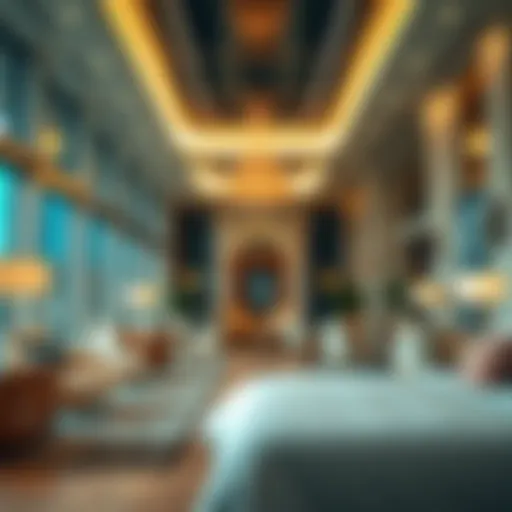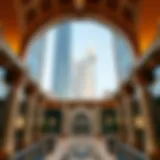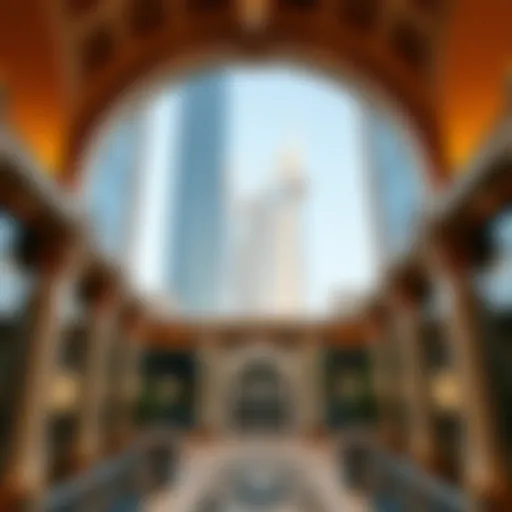Exploring Sheikh Rashid Building: Architecture and Economics
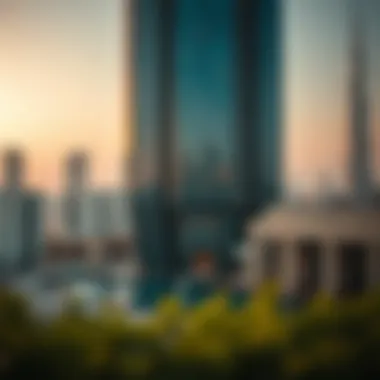

Intro
The Sheikh Rashid Building stands as a beacon in the heart of Dubai, symbolizing the city’s rapid transformation and architectural ambition. Located amidst a bustling real estate climate, this building is not just a structure; it is a statement of intent and innovation. As Dubai continues to position itself as a global hub for business and tourism, the Sheikh Rashid Building plays a pivotal role in shaping both the skyline and the economic landscape of the area. Given the current trends in real estate, a close look at this architectural marvel reveals insights into its contemporary significance and future prospects.
Market Trends
Current Market Analysis
In the wake of unprecedented growth, the Dubai real estate market has proven both resilient and adaptive. The Sheikh Rashid Building, with its striking design and prime location, exemplifies the high interest observed in Dubai properties. Investors today are more than just buying a plot of land; they seek opportunities that align with their vision of growth and sustainability. The influx of foreign investors has surged, driven by favorable government policies and an increased interest in long-term residency visas.
According to recent reports, the average price per square foot in Dubai has been on a steady rise, with some areas witnessing appreciation rates that are hard to overlook. The Sheikh Rashid Building, situated in a strategic urban center, is part of this narrative, attracting a diverse range of tenants from multinational corporations to innovative startups.
Future Predictions
Looking ahead, one can expect the Dubai real estate market to evolve further, pivoting towards sustainability and smarter living solutions. With the ongoing efforts to enhance the livability and economic vibrancy of the city, projects like the Sheikh Rashid Building are well-poised for future appreciation.
In the coming years, it is reasonable to anticipate a shift toward hybrid living and working spaces. Predictions suggest that investments in technology and sustainable building practices will continue to define the next wave of development. Economic diversification will be essential, with stakeholders adapting to market demands and trends that prioritize environmental responsibility.
"The Sheikh Rashid Building is not just about architectural prowess; it's about adaptive evolution within a competitive market." - Real Estate Analyst
Property Types
Residential Properties
With residential properties becoming increasingly sought after, the Sheikh Rashid Building offers a unique living experience. The apartments are not merely homes; they are gateways to a lifestyle intertwined with the vibrancy of Dubai’s culture. Urban planners have envisioned spaces in the building that are not just habitable but are also community-oriented, hence fostering interaction among residents.
Apartments within this development typically boast stunning views of the skyline, and many come equipped with modern amenities that enhance the quality of living. In a location so rich with activities, residents find themselves living within a stone’s throw of shops, entertainment, and cultural experiences.
Commercial Properties
On the commercial front, the Sheikh Rashid Building has positioned itself as a hotbed for businesses eager to tap into Dubai’s lucrative economic environment. Many corporations, ranging from tech firms to consultancies, have established offices within its walls, drawn not only by the building's aesthetic but also by its strategic connections to key transport routes.
Commercial spaces here cater to a diverse clientele, promoting both small startups and established enterprises, thus enriching the local economy. The trend toward mixed-use developments suggests a future where businesses and residences are seamlessly integrated, making buildings like Sheikh Rashid increasingly valuable.
For more insights and up-to-date information on Dubai's real estate and economic strategies, you can explore resources from Wikipedia, Britannica, and Reddit.
Prelims to Sheikh Rashid Building
The Sheikh Rashid Building stands out as a pillar of architectural achievement in the bustling landscape of Dubai. This building does not just contribute to the skyline; it embodies the ambition and vision that define the city’s rapid growth. Notably, it symbolizes a turning point in Dubai's evolution from a modest trading port to an international hub of commerce and luxury.
This structure, housing various state-of-the-art facilities, merges utility with aesthetic appeal. It reflects how modern architecture can respond to both economic forces and community needs. Investors and home buyers alike find the Sheikh Rashid Building significant due to its strategic location and the amenities offered, thus making it a key player in the local real estate market.
Importance of the Building
Understanding the Sheikh Rashid Building is crucial for several reasons:
- Economic Driver: It acts as a catalyst in the real estate sector, influencing market trends and attracting global investors.
- Cultural Landmark: The design and function of the building contribute to Dubai’s cultural tapestry, making it not just a place to work or live, but a space of social interaction.
- Sustainable Practices: With increasing awareness around sustainability, the building showcases modern techniques that aim for energy efficiency, appealing to environmentally conscious stakeholders.
- Community Integration: It plays a role in the local community dynamics by providing essential services that cater to residents and businesses.
By examining the Sheikh Rashid Building’s architectural and economic aspects, we glean insights that extend beyond the structure itself. These insights inform various stakeholders—whether they are investors looking for strategic opportunities or renters seeking homes in a vibrant area—about what makes this building integral to Dubai’s ongoing story.
"Architecture is not just about creating a building, but establishing a setting that influences society and economy."
In summary, the relevance of the Sheikh Rashid Building extends into the architectural, cultural, and economic spheres. Through this article, readers will explore these dimensions in detail, offering a comprehensive understanding of its significance in the broader context of Dubai's dynamic landscape.
Architectural Significance
The architectural significance of the Sheikh Rashid Building is not just limited to its imposing presence against the Dubai skyline. It represents a confluence of modernity, cultural identity, and functional design, elevating it to a position of notable importance in the real estate landscape of Dubai. The building showcases the potential that contemporary architecture has to influence urban development while reflecting the aspirations of a rapidly growing city.
Design Overview
At first glance, the Sheikh Rashid Building captivates with its unique silhouette and harmonious proportions. The design integrates both aesthetic appeal and functionality, featuring expansive glass facades that allow natural light to fill the interiors, creating an inviting atmosphere. The use of clean lines and geometric forms not only amplifies its modern persona but also aids in achieving energy efficiency.
The layout of the building is meticulously planned. Open floor spaces promote flexibility for various uses, catering to both commercial and residential needs. The blend of open areas with functional rooms allows for seamless movement and interaction among occupants, which is particularly appealing for businesses aiming to foster collaboration.
Construction Materials
In crafting the Sheikh Rashid Building, innovative construction materials were employed that elevate durability and sustainability. Reinforced concrete forms the backbone of the structure, offering strength while maintaining a sleek aesthetic. Alongside traditional materials, environmentally-friendly alternatives such as recycled glass and low-VOC paints have been incorporated.
The choice of materials not only caters to the visual aspects but also considers the building's carbon footprint. This focus on sustainability can significantly enhance the building's marketability, particularly among environmentally conscious investors and occupants looking for low-impact living options.
Innovative Features
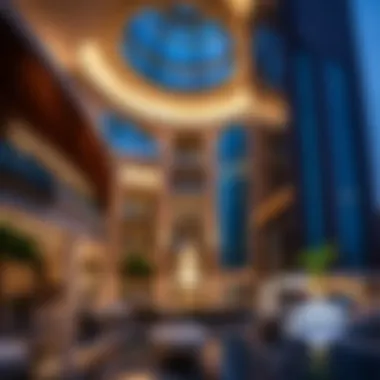

What sets the Sheikh Rashid Building apart from its peers are the standout innovative features integrated into its design. One such aspect is the smart building technology embedded within its infrastructure. This includes energy-efficient systems for heating, cooling, and lighting, which adjust based on occupancy and external conditions. Such innovations lead to reduced operational costs and greater comfort for residents and tenants alike.
Additionally, green terraces and gardens are strategically placed throughout the building. These outdoor spaces not only enhance the aesthetic experience for tenants but also contribute to biodiversity by supporting local flora and fauna. This focus on creating green spaces within an urban environment reflects a growing trend toward sustainability in architectural design, making the Sheikh Rashid Building a forward-thinking model in Dubai’s real estate sector.
"The Sheikh Rashid Building exemplifies the future of urban architecture, merging sustainability with functionality in the heart of Dubai's dynamic landscape."
In summary, the architectural significance of the Sheikh Rashid Building extends well beyond its exterior. The thoughtful design, choice of materials, and pioneering features demonstrate a commitment to sustainability and innovation, which will undoubtedly inspire future developments within the burgeoning skyline of Dubai.
Historical Context
Understanding the historical context of the Sheikh Rashid Building provides a critical lens through which to view its significance in Dubai's architectural and economic landscape. This examination is pivotal as it highlights how the city has evolved alongside its iconic structures. The Sheikh Rashid Building isn't just a piece of architecture; it represents a turning point in Dubai's journey towards becoming a global city. The importance is multifaceted, encompassing social, economic, and cultural dimensions.
Development Timeline
The story of the Sheikh Rashid Building is firmly tied to Dubai's rapid transformation from a modest trading hub to a dazzling global metropolis.
- 1990s: The initial conceptualization began during this decade, which was pivotal in the shaping of modern Dubai. As the economy grew, so did the need for buildings that signified ambition and progress.
- 2000: The official commencement of construction marked a significant leap in the developmental timeline. Architects and planners worked hand-in-hand, embracing modern designs that would attract both local and international attention.
- 2004: The building was finally completed. Its launch was met with enthusiasm, not only from investors but also from the general public, who saw it as a symbol of the future.
What is particularly interesting is how the building reflects the wider narrative of Dubai’s economic boom. Developers took risks here, pushing boundaries, and the outcome was not just a building, but a landmark that embodies aspirations.
Cultural Influence
Culturally, the Sheikh Rashid Building serves as a crucial point of reference in the dialogue about architectural identity in Dubai.
- Architectural Fusion: The design of the building integrates traditional Middle Eastern aesthetics with modern architectural techniques. This fusion speaks volumes about Dubai’s cultural melting pot.
- Symbol of Unity: In a city where diverse cultures converge, the Sheikh Rashid Building stands as a unifying figure. It has become a backdrop for countless cultural events, celebrations, and community gatherings.
- Tourism Magnet: As a significant landmark, it attracts tourists and culture enthusiasts, enhancing the cultural fabric of the vicinity.
Art and architecture aren’t merely decorative in Dubai; they are entwined with the identity of the people and express an aspirational outlook toward the future.
Previous Land Uses
Before the Sheikh Rashid Building took its place in the skyline, the land it occupies had a rich and varied history. Understanding its previous uses adds layers to our appreciation of its current significance.
- Commercial Activities: The site once hosted small trading units, showcasing Dubai’s roots in commerce and trade. This legacy is a testament to the city’s entrepreneurial spirit, which sparked its growth.
- Residential Spaces: Prior to its development into a commercial building, parts of the land were used for residential properties, representing a community-oriented environment that has shifted dramatically over the years.
- Public Spaces: Elements of parks and local markets contributed to a social fabric that allowed for community cohesion before the building reshaped the landscape.
The transformation of this land from a communal hub to a towering emblem of modernity illustrates the tensions and triumphs of urban development. Each layer of history provides insight into Dubai's gradual shift, reflecting both its past dependencies and future ambitions.
Economic Impact
The economic ramifications of the Sheikh Rashid Building are extensive and merit serious consideration. As a keystone in Dubai's architectural landscape, its influence extends beyond mere aesthetics. This section aims to illuminate the advantages and complexities that stem from its existence—factors that investors, homebuyers, real estate agents, property managers, and renters alike should keep in mind.
Real Estate Market Trends
The presence of the Sheikh Rashid Building has undoubtedly shaped the real estate market trends within its vicinity. When it first emerged, it marked a shift in local property values, sparking both interest and investment in surrounding areas. The influx of residential complexes and commercial spaces around the building can be attributed to its high visibility and prestige—a hallmark that attracts both high-end and mid-range buyers.
Key Points to Consider:
- Property Value Appreciation: Properties surrounding the building have seen a marked increase in their market values. Investors looking to capitalize on such opportunities should keep a close eye on price trends.
- Emergence of New Developments: Other developers have taken cues from the Sheikh Rashid Building, leading to a slew of new projects within the neighborhood. This has led to an increase in choices for potential residents and investors.
- Demographics Shifts: The building has attracted a diverse crowd, not only from the local Emirati population but also expatriates, thus affecting the demand for commercial and residential properties in the area.
Investment Opportunities
The Sheikh Rashid Building represents not just a landmark but a goldmine of investment opportunities. With its architectural allure and prime location, the surrounding area offers a fertile ground for both seasoned and new investors.
Opportunities Available:
- Commercial Leasing: Businesses looking for prime retail space can benefit from the foot traffic generated by the building, thus making commercial properties a viable investment. The steady demand from businesses ensures a reliable income stream.
- Residential Units: With rising demand for rentals, investing in nearby residential units can be lucrative. Reports suggest that occupancy rates have been consistently high, signaling a strong rental market.
- Partnerships and Joint Ventures: The government of Dubai has been welcoming foreign investments, creating a space for joint ventures in real estate. Investors can harness this to undertake new projects, leveraging the reputation of Sheikh Rashid and its successful economic model.
Rental Market Analysis
The rental market around the Sheikh Rashid Building is a focal point for prospective tenants and investors alike. Understanding this segment can greatly influence investment decisions and rental strategies.
Trends and Observations:
- Competitive Rental Prices: With rising property values, rental prices have also seen an uptick. It's essential for landlords to price their units competitively to attract a broader pool of renters while still achieving a reasonable return.
- High Occupancy Rates: The allure of living near such a landmark means that properties often maintain high occupancy rates, which is a positive sign for landlords looking for stable income.
- Amenities Driving Demand: The surrounding amenities, including shopping districts and transport links, add considerable attraction to rental units, creating a win-win for tenants and landlords.
The substantial economic impact of the Sheikh Rashid Building extends beyond its design—it's a catalyst for growth, innovation, and opportunity.
In summary, the Sheikh Rashid Building holds a transformative role in the economic landscape of Dubai. By evaluating real estate trends, investment prospects, and the dynamics of the rental market, stakeholders can make informed decisions that align with their goals.
Regulatory Considerations
Understanding the regulatory environment surrounding the Sheikh Rashid Building is crucial for anyone interested in its architectural marvel and economic impact. Regulations set by local government bodies decide what can be built, how it can be used, and its potential effects on the neighborhood. Look at it this way: regulations aren't just red tape; they are the framework that ensures developments contribute positively to the city’s planning goals and maintain community integrity. The adherence to zoning laws and the permitting process can ultimately shape the success of investments within Dubai’s real estate market.
Zoning Laws
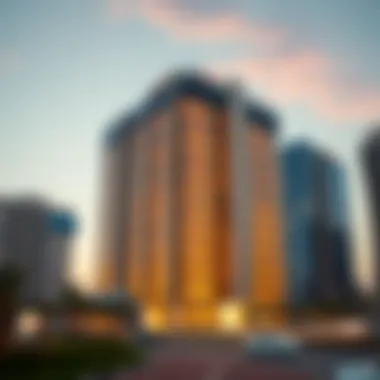

Zoning laws are often the backbone of urban planning, and they delineate what types of buildings can be constructed in given areas. For the Sheikh Rashid Building, these laws play a vital role in the building’s design, utilization, and operational characteristics. Generally, zoning regulations may specify factors such as:
- Building height and density: These parameters help preserve views and prevent overcrowding.
- Land use designation: This indicates whether the building is for commercial, residential, or mixed-use purposes, which heavily influences potential revenue streams.
- Setback requirements: These dictate how far buildings must be from property lines, impacting the overall layout and pedestrian flow.
Knowing these laws offers insights into how the Sheikh Rashid Building fits into the fabric of Dubai’s urban landscape. For instance, strict zoning rules may enhance property values by maintaining exclusivity, while relaxed regulations could allow for greater innovation in community-focused design.
Permitting Process
The permitting process is another considerable aspect linked to regulatory considerations. A robust permitting process ensures that structures like the Sheikh Rashid Building adhere to safety and environmental standards. Typically, the steps involved in granting permits include:
- Pre-application Consultation: This is where developers meet with city planners to discuss project feasibility and gather insights.
- Submitting Plans: Developers provide detailed plans illustrating the proposed use and impact of the building.
- Public Comment Period: Local communities are often invited to share their opinions regarding the new building, fostering civic engagement.
- Approval or Denial: The final decision is made based on various assessments, including environmental impact and compliance with existing laws.
Understanding this process is especially significant for investors and real estate agents as it determines timelines and costs associated with development. The importance of thorough planning cannot be overstated—successful navigation through this labyrinthine system can confer significant economic advantages and shape the functionality of Sheikh Rashid Building in meeting local needs.
"Regulatory frameworks are not barriers; they are guideposts steering development towards sustainable, community-responsive solutions."
In summary, the regulatory considerations stemming from zoning laws and the permitting process play an instrumental role in defining the parameters within which the Sheikh Rashid Building operates. By grasping these aspects, investors, home buyers, and property managers can make more informed decisions, thereby enhancing their engagement with this notable structure in Dubai.
Amenities and Services
Amenities and services are crucial elements that can dictate the desirability and functionality of any building, including the Sheikh Rashid Building. Investing in real estate not only involves looking at mere structures but also evaluating the various offerings that enhance life and work within those spaces. Understanding what the Sheikh Rashid Building brings to the table in terms of amenities and services is essential for potential investors, home buyers, real estate agents, property managers, and renters alike. These elements not only foster a vibrant community but also contribute significantly to enhancing property value.
Commercial Spaces
The availability of commercial spaces within the Sheikh Rashid Building provides a considerable advantage for local businesses and entrepreneurs. These spaces cater to a variety of enterprises, from retail shops to corporate offices, encouraging bustling economic activity. Having commercial units in the same building where people live and work can foster an integrated experience, making necessities accessible without the hassle of long commutes. Well-designed commercial spaces can attract foot traffic, thereby supporting local businesses.
- Convenience: Residents benefit from easy access to shops and services, reducing time spent on errands.
- Employment Opportunities: Local businesses create jobs, contributing to the local economy and generating income.
- Diverse Offerings: A mix of retail, dining, and service-oriented establishments can cater to varied tastes and necessities.
Investors should note that commercial spaces can be a significant revenue source through leasing, enhancing the overall economic viability of the Sheikh Rashid Building.
Residential Options
In terms of residential offerings, the Sheikh Rashid Building shines by presenting various living options tailored to different lifestyles. The mixture of apartments and other types of residences means there's likely something for everyone, from young professionals to families seeking larger units. These options enrich the community, encouraging a sense of belonging, which is essential for a thriving neighborhood.
- Diverse Unit Sizes: Potential buyers or renters find choices in size and layouts, accommodating different needs and preferences.
- Modern Amenities: Residences may come with modern conveniences such as high-speed internet, smart home features, and energy-efficient appliances, greatly enhancing the living experience.
- Sense of Community: Residential options can often lead to shared communal spaces, strengthening relationships and interactions among residents.
Such qualities make the Sheikh Rashid Building a tempting alternative for individuals and families looking to relocate within Dubai's bustling urban landscape.
Recreational Facilities
Recreational facilities in the Sheikh Rashid Building are indispensable for residents. These spaces not only uplift quality of life but also play a vital role in community bonding and wellness. From gyms and swimming pools to rooftop gardens and playgrounds, the presence of recreational facilities demonstrates a commitment to the well-being of residents.
"Investing in the health and recreation of residents translates into happier communities and, ultimately, stronger property value."
- Health and Wellness: Access to gyms and pools allows residents to maintain a healthy lifestyle without needing to travel.
- Social Spaces: Recreational facilities serve as venues for gathering, whether it be in playgrounds for children or common areas for meetings and events.
- Environmental Benefits: Green spaces within or around the buildings can not only enhance aesthetics but also offer a breath of fresh air amidst urban density.
In summary, the amenities and services offered by the Sheikh Rashid Building are interconnected aspects that cater to a range of needs, ultimately driving its demand in a competitive market. Given the shifting dynamics in urban living preferences, it is crucial for investors and residents to grasp the value brought forth through the various amenities and services available.
Community Integration
Community integration is a focal point of urban development in modern architecture, and the Sheikh Rashid Building exemplifies this concept. The relationship between the built environment and the surrounding community shapes not only the physical landscape but also the social fabric of a city. The significance of this building goes beyond its striking design; it stands as a bridge that connects various stakeholders in Dubai's evolving urban ecosystem.
Local Neighborhood Dynamics
The dynamics of the local neighborhood around the Sheikh Rashid Building play a pivotal role in its success as a communal space. This area is characterized by a colorful tapestry of residents – from expatriates to locals, each bringing unique cultures and lifestyles. This mixture creates a vibrant atmosphere that can appeal to potential buyers and investors.
- Community Programs: Local events help foster unity, drawing people from various backgrounds, which in return stimulates businesses within the vicinity. Regular activities like cultural festivals or weekend markets engage families and promote foot traffic near the building.
- Safety and Connectivity: A sense of community encourages safety. Areas where residents interact tend to report lower crime rates. Moreover, interconnected pathways and communal zones within the development ensure ease of movement and accessibility.
Building relationships among residents also augments property values. When neighbors know each other, it cultivates trust, vital for long-term investment. Understanding local dynamics means investors can better predict trends in the real estate market and tailor their strategies accordingly, which is inherently advantageous.
Public Transport Access
Accessibility is another key element of community integration, and the Sheikh Rashid Building is well-positioned to leverage it. Dubai's robust public transport network significantly affects the desirability of any location. The availability of buses, the metro, and water taxis nearby facilitate not just commuting but also social interactions among residents.
- Metro Stations: The proximity to metro lines allows for quick travel to other parts of the city, providing an ease of access that enhances the appeal of the building for both potential residents and business owners.
- Bus Routes: Integration with bus services offers flexibility, catering to those who may not wish to rely solely on metro, thus broadening the potential user base.
For investors and stakeholders, well-connected locations often promise better returns. Knowing that residents can navigate the city conveniently helps keep both occupancy and property values high.
Civic Engagement and Activities
Engaging the community actively involves establishing platforms for civic participation. Events organized around the Sheikh Rashid Building can be a catalyst for enthusiastic involvement. When residents feel their voices matter, the overall societal vibes flourish.
- Workshops and Forums: Hosting informative sessions about urban gardening or local history can foster relationships and a shared sense of purpose among residents. It helps unite people around common interests.
- Volunteer Initiatives: Opportunities for residents to give back, whether through clean-up drives or charity events, also create stronger bonds, transforming the building into a hub of community spirit.
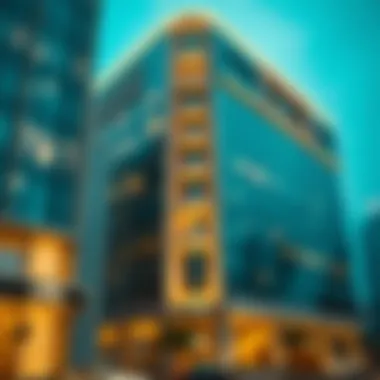

Moreover, civic engagement translates into loyalty toward the area. When residents are invested, they are more likely to stay, increasing demand for housing in the long run.
In sum, the Sheikh Rashid Building is not just a landmark in Dubai. Its role in community integration creates a ripple effect, nurturing local relations, accessibility, and citizen engagement. Each of these elements plays a crucial part in enhancing the overall value of the property while cultivating a cohesive urban atmosphere. The benefits of investing or dwelling in such an integrated community are substantial, making Sheikh Rashid a noteworthy consideration for modern investors and residents alike.
Sustainability Initiatives
In recent years, the significance of sustainability in architecture has taken center stage, as the world confronts the pressing challenges of climate change and resource depletion. The Sheikh Rashid Building, a prominent fixture in Dubai’s skyline, embodies this shift towards environmentally conscious design. These sustainability initiatives not only play a critical role in reducing the building's ecological footprint but also enhance the property’s value, making it attractive for investors and residents alike.
Benefits of Sustainability Initiatives:
- Environmental Responsibility: Incorporating green practices addresses environmental concerns, promoting conservation and efficiency.
- Economic Value: Sustainable buildings tend to have lower operating costs, appealing to both property managers and tenants.
- Regulatory Compliance: With growing governmental regulations, proactive adoption of sustainability standards keeps the building in line with future mandates.
- Enhanced Reputation: Committing to sustainability enhances the building's public image, attracting eco-conscious buyers and tenants.
Embracing sustainability is not just a trend; it is a fundamental shift in how architecture aligns with the environment and society.
Energy Efficiency Measures
Energy efficiency is a cornerstone of the Sheikh Rashid Building’s sustainability strategy. This is achieved through multiple methods, each aimed at minimizing energy consumption while maximizing comfort for its occupants.
- High-Performance Glazing: The use of double-glazed windows reduces heat gain and loss, requiring less energy for heating and cooling.
- Efficient HVAC Systems: Smart heating, ventilation, and air conditioning systems are installed to optimize energy use based on building occupancy.
- LED Lighting: This energy-efficient lighting solution not only lowers energy costs but also offers a longer lifespan compared to traditional bulbs.
- Building Automation Systems: Automating various energy-consuming elements allows for monitoring and adjustment, leading to significant energy savings.
These measures collectively result in a building that respects both the environment and its inhabitants.
Green Building Certifications
Achieving notable green building certifications is another aspect of the Sheikh Rashid Building’s commitment to sustainability. Certifications like Leadership in Energy and Environmental Design (LEED) or Estidama represent benchmarks for best practices in sustainable design.
- LEED Certification: It focuses on various areas including sustainable site development, water savings, energy efficiency, and material selection. This is increasingly attractive for eco-conscious investors.
- Estidama: This initiative aligns with Abu Dhabi’s environmental goals, promoting sustainability in the UAE.
- BREEAM: The Building Research Establishment Environmental Assessment Method is another sought-after certification that evaluates the sustainability of new buildings.
These certifications reflect a building's commitment to reducing its impact on the environment, while also offering a competitive edge in the real estate market. In the long run, sustainability initiatives like these contribute to the overall desirability of the Sheikh Rashid Building, ensuring its place as a leader in Dubai’s real estate sector.
As the landscape of architecture continues shifting towards sustainable practices, buildings like Sheikh Rashid are paving the way for future developments, creating spaces that are both innovative and responsible.
Future Prospects
The future prospects of the Sheikh Rashid Building are pivotal, not just for the edifice itself but also for the broader real estate landscape in Dubai. As a focal point of growth and opportunity, understanding the forthcoming developments is crucial for investors, home buyers, and property managers alike.
Market Predictions
Market predictions surrounding Sheikh Rashid Building point towards a continually strengthening real estate sector in Dubai. With indicators indicating positive trends, experts speculate that property values in the vicinity will not just hold but grow over the next few years. The desire for commercial and residential spaces has taken on a new shape, owing to the influx of expatriates and investments, making it a hotspot for both living and business endeavors.
For example, analysts foretell that with the UAE's ongoing efforts to diversify its economy and attract foreign investors, developments like Sheikh Rashid Building will see a rise in demand. This shift is expected to lead to:
- Sustained rental growth fueled by increasing resident numbers.
- Enhanced property values within close proximity to the building.
Moreover, as economic conditions become more favorable, projections also hint at a possible increase in the average return on investment (ROI) for property owners, making this a highly attractive proposition for future stakeholders.
Potential Developments
Looking ahead, several potential developments could further enhance the Sheikh Rashid Building's significance. Not only will the structure itself continue to evolve, but the surrounding area is also expected to undergo transformative changes driven by urban development initiatives.
Some notable potential developments include:
- Expansion of Commercial Spaces: Increased demand for office space is anticipated. With Dubai being a major business hub, further commercial expansions in the Sheikh Rashid area may provide necessary amenities to companies looking for prime locations.
- Integration with Smart City Initiatives: Dubai's aim to be a leader in smart city development may see Sheikh Rashid Building becoming part of an integrated digital environment, focusing on sustainability and enhanced services. This can attract tech-driven businesses and provide residents with state-of-the-art conveniences.
- Improved Infrastructure: Ongoing and planned infrastructure projects will likely improve access to the Sheikh Rashid Building, making it even more appealing for knowledge workers and visitors. Enhanced public transport systems could lead to increased foot traffic, benefiting both local businesses and the building occupants.
As the city continues to develop and adapt to global challenges, the Sheikh Rashid Building stands at an advantageous position. Its potential for growth and economic impact cannot be understated; thus, it’s important for investors and other stakeholders to keep a close eye on the market and emerging developments.
"In real estate, the greatest opportunity lies not just in the present, but in anticipating the future."
With the appropriate awareness and foresight regarding trends and opportunities, stakeholders can harness potential within the evolving landscape of Dubai’s real estate sector.
Epilogue
In wrapping up this analysis, it's crucial to underscore the significance of the Sheikh Rashid Building within Dubai's evolving urban fabric. This structure stands as more than just a physical entity; it symbolizes economic growth, architectural innovation, and cultural progression. As we reflect on the insights presented, several key elements should be highlighted.
Summary of Key Insights
- Architectural Features: The Sheikh Rashid Building showcases a blend of modern design and traditional influences, serving as a testament to Dubai's ambitious architectural vision.
- Historical Context: Understanding the timeline of development reveals how this building fit into the broader narrative of Dubai's transformation from a modest trading port to a global metropolis.
- Economic Impact: The implications for the real estate market are multi-faceted, including increased property values and enhanced attractiveness for investments.
"The Sheikh Rashid Building is a microcosm of Dubai’s broader aspirations—reflecting both its storied past and its ambitions for the future."
For stakeholders, comprehending these insights allows for informed decision-making, whether one is looking to invest in property, negotiate rents, or understand market dynamics.
Implications for Stakeholders
The implications of this analysis for various stakeholders are substantial. Investors and developers can glean insights into market trends, positioning their investments strategically to yield optimal returns. Understanding rental market analysis also plays a crucial role in setting competitive pricing, especially in a market as dynamic as Dubai’s.
Home buyers and renters benefit too; knowledge about the building’s amenities and its integration with community dynamics can guide their choices in selecting a living space.
Real estate agents can utilize the insights gained about this property's historical context and economic effects in their pitches or listings.



